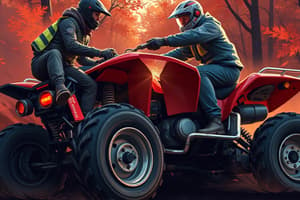Podcast
Questions and Answers
Carrying a map and compass is a good riding practice.
Carrying a map and compass is a good riding practice.
True (A)
Always remove a helmet from an injured rider.
Always remove a helmet from an injured rider.
False (B)
Most accidents are preventable.
Most accidents are preventable.
True (A)
Most ATVs are designed to carry an operator and a passenger.
Most ATVs are designed to carry an operator and a passenger.
Wearing a helmet will reduce normal peripheral vision.
Wearing a helmet will reduce normal peripheral vision.
Looking at the controls while riding is a SAFE action.
Looking at the controls while riding is a SAFE action.
To remember the pre-ride inspection procedure, use T-CLOC.
To remember the pre-ride inspection procedure, use T-CLOC.
The parking brake should be set when rocking the ATV to check for neutral.
The parking brake should be set when rocking the ATV to check for neutral.
It is best to look down at the stopping point when using the brakes.
It is best to look down at the stopping point when using the brakes.
Adults in the lives of youth need to supervise riders directly, ensure they wear proper gear, and follow safe riding practices.
Adults in the lives of youth need to supervise riders directly, ensure they wear proper gear, and follow safe riding practices.
An ATV should be considered a family toy.
An ATV should be considered a family toy.
Drivers should carry no more than one passenger on an ATV specifically designed for two.
Drivers should carry no more than one passenger on an ATV specifically designed for two.
Studies have shown that wearing a helmet does not reduce essential vision or hearing.
Studies have shown that wearing a helmet does not reduce essential vision or hearing.
The single most important piece of protective equipment gear you can wear riding an ATV is an _______________.
The single most important piece of protective equipment gear you can wear riding an ATV is an _______________.
Braking and swerving at the same time could result in a spill.
Braking and swerving at the same time could result in a spill.
Operating an ATV without ______________________________ such as a face shield or goggles can result in an accident and increase chances of eye injury.
Operating an ATV without ______________________________ such as a face shield or goggles can result in an accident and increase chances of eye injury.
______________ can be worn to protect hands from becoming sore, cold, or to provide protection in a crash.
______________ can be worn to protect hands from becoming sore, cold, or to provide protection in a crash.
Footwear with _______________ will prevent your feet from sliding off the footrests.
Footwear with _______________ will prevent your feet from sliding off the footrests.
Helmets protect the head from _______________ and _______________ injuries.
Helmets protect the head from _______________ and _______________ injuries.
When rolling backward down a hill, the rider should apply the rear brakes.
When rolling backward down a hill, the rider should apply the rear brakes.
A small waterproof container should be used to store a first aid and survival kit.
A small waterproof container should be used to store a first aid and survival kit.
Flashcards are hidden until you start studying
Study Notes
ATV Safety Training Overview
- Carrying a map and compass is essential for safe riding.
- Never remove a helmet from an injured rider to avoid further injury.
Accident Prevention
- Most ATV accidents are preventable through proper safety measures.
- ATVs are designed for the operator only; carrying passengers is not recommended unless the ATV is specifically designed for it.
Safety Gear and Visibility
- Wearing a helmet does not impair peripheral vision or hearing; it is crucial for protection.
- Looking down at the controls while riding is unsafe; maintain focus on the path ahead.
Pre-Ride Safety Protocol
- Use T-CLOC (Tires, Controls, Lights, Oil, Chassis) as a mnemonic for the pre-ride inspection.
Responsible Adult Supervision
- Adults must supervise young riders, ensuring they wear appropriate safety gear and follow safe riding practices.
Passenger Guidelines
- Only one passenger is allowed on ATVs designed for two riders.
Protective Equipment
- Helmets are the most critical piece of safety gear for ATV riders.
- Face shields or goggles are necessary to protect the eyes during operation.
- Gloves help prevent soreness, cold, and provide protection during crashes.
- Footwear with heels helps prevent feet from sliding off footrests.
Injury Prevention
- Helmets protect against impact and puncture injuries.
- Avoid using rear brakes when rolling backward down a hill to prevent loss of control.
Emergency Preparedness
- A small waterproof container is essential for storing a first aid and survival kit for emergencies.
Studying That Suits You
Use AI to generate personalized quizzes and flashcards to suit your learning preferences.




